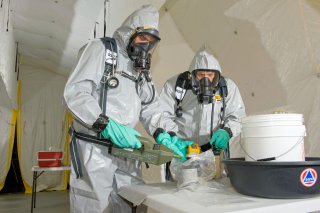The Basics of Water Remediation
The remediation process consists of actions taken by a drinking water or wastewater utility to return to normal service after a confirmed contamination incident. A contamination incident is the confirmed presence of any chemical, biological, or radiological substance in a significant enough concentration to result in an adverse effect on public health and/or the environment.
A remediation process timeframe will be determined on an incident-specific and site-specific basis and can vary from hours to months or years if infrastructure replacement is required. The remediation process is divided into three phases: Characterization, Decontamination, and Clearance. However, depending on other response efforts, these phases may overlap or occur simultaneously.
Characterization

The goal of the Characterization Phase is to discover as much as possible about the extent of contamination. This includes defining what the contaminants are and how they interact and travel in water, measuring contaminant concentrations to determine the magnitude of contamination, and locating the contaminants throughout the system to identify the extent to which remediation will be required. This is accomplished through coordination and communication with a variety of emergency response partners and strategic sampling throughout the system. Sampling locations can include standard monitoring locations at critical points in the system, residential or recreational waters, as well as locations where contamination is suspected to be the highest.
Throughout this phase, information on public health and environmental risks are used to identify any protective measures, such as a boil water notice, that may be needed throughout the remediation process. Once the extent of contamination and the risks are defined, a clearance goal is set, which is the contaminant concentration at which the system may be returned to normal service and is not expected to present a risk to public health and the environment.
Decontamination

The Decontamination Phase involves the selection and implementation of water treatment and infrastructure decontamination. Water treatment methods are selected based on a variety of factors including effectiveness, availability of resources, time, and cost. EPA provides a general Overview of Drinking Water Treatment Technologies.
Depending on the contaminant properties and the locations identified throughout the system, sometimes infrastructure decontamination is necessary. This could include removing contaminants from surfaces like pipes, valves, and tanks, or replacement of certain infrastructure altogether.
The Decontamination Phase also includes the management and disposal of any contaminated wastes. This could include contaminated water or infrastructure unable to be decontaminated, or byproducts generated during decontamination activities.
Clearance

The Clearance Phase involves sampling and data review to determine if the clearance goals have been met. Clearance sampling is done thorough EPA-approved analytical methods to ensure compliance with regulations. To learn more visit: Methods Approved to Analyze Drinking Water Samples to Ensure Compliance with Regulations.
If clearance has been met, the water system can be returned to normal service. In some cases, specific areas of the system might be cleared while other areas are still undergoing decontamination. The system may also need to perform long-term monitoring after the system has been cleared and normal service has been restored. Long-term monitoring provides information to confirm the effectiveness of the remediation process.
